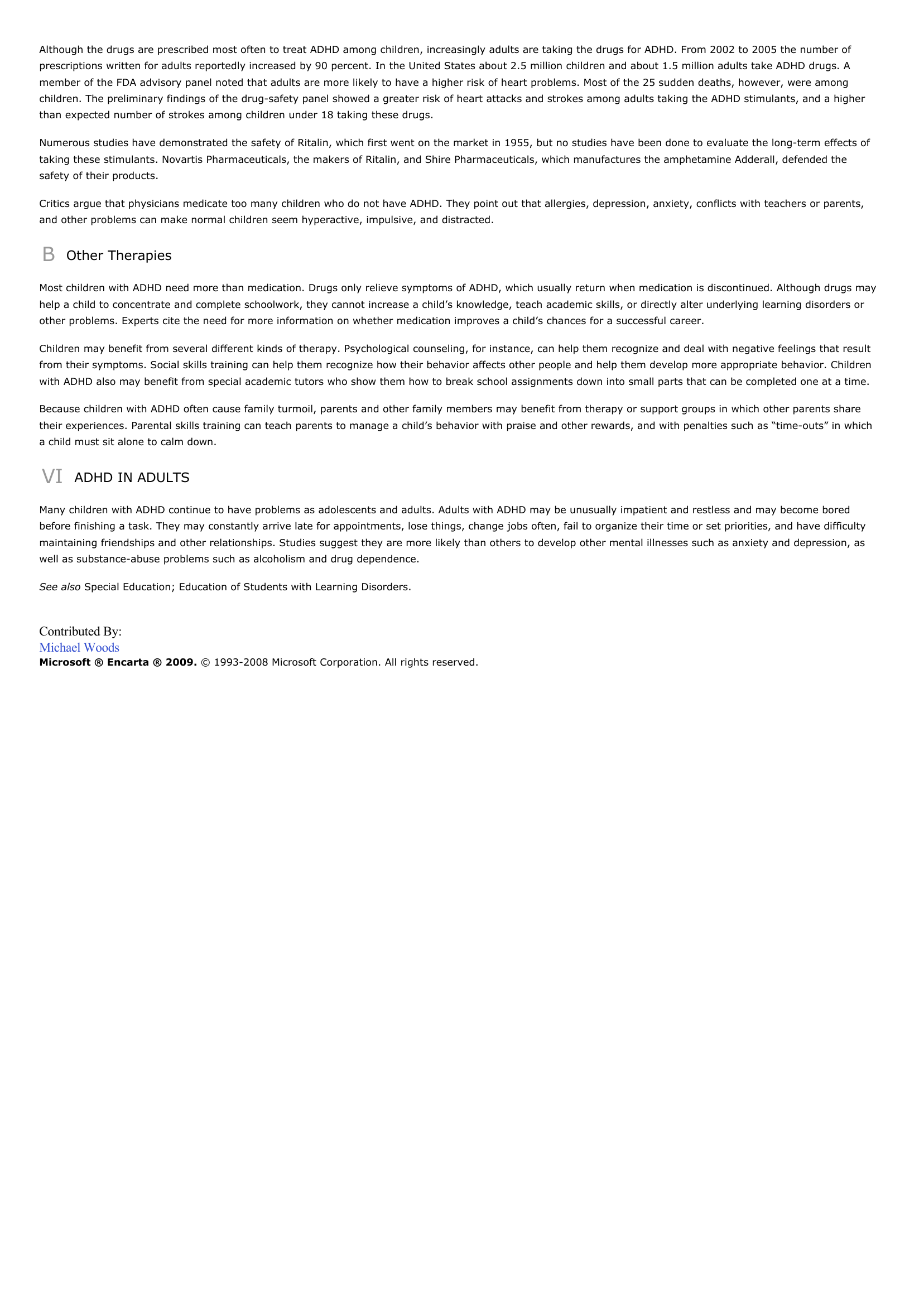Attention-Deficit Hyperactivity Disorder.
Publié le 10/05/2013
Extrait du document
«
Although the drugs are prescribed most often to treat ADHD among children, increasingly adults are taking the drugs for ADHD.
From 2002 to 2005 the number ofprescriptions written for adults reportedly increased by 90 percent.
In the United States about 2.5 million children and about 1.5 million adults take ADHD drugs.
Amember of the FDA advisory panel noted that adults are more likely to have a higher risk of heart problems.
Most of the 25 sudden deaths, however, were amongchildren.
The preliminary findings of the drug-safety panel showed a greater risk of heart attacks and strokes among adults taking the ADHD stimulants, and a higherthan expected number of strokes among children under 18 taking these drugs.
Numerous studies have demonstrated the safety of Ritalin, which first went on the market in 1955, but no studies have been done to evaluate the long-term effects oftaking these stimulants.
Novartis Pharmaceuticals, the makers of Ritalin, and Shire Pharmaceuticals, which manufactures the amphetamine Adderall, defended thesafety of their products.
Critics argue that physicians medicate too many children who do not have ADHD.
They point out that allergies, depression, anxiety, conflicts with teachers or parents,and other problems can make normal children seem hyperactive, impulsive, and distracted.
B Other Therapies
Most children with ADHD need more than medication.
Drugs only relieve symptoms of ADHD, which usually return when medication is discontinued.
Although drugs mayhelp a child to concentrate and complete schoolwork, they cannot increase a child’s knowledge, teach academic skills, or directly alter underlying learning disorders orother problems.
Experts cite the need for more information on whether medication improves a child’s chances for a successful career.
Children may benefit from several different kinds of therapy.
Psychological counseling, for instance, can help them recognize and deal with negative feelings that resultfrom their symptoms.
Social skills training can help them recognize how their behavior affects other people and help them develop more appropriate behavior.
Childrenwith ADHD also may benefit from special academic tutors who show them how to break school assignments down into small parts that can be completed one at a time.
Because children with ADHD often cause family turmoil, parents and other family members may benefit from therapy or support groups in which other parents sharetheir experiences.
Parental skills training can teach parents to manage a child’s behavior with praise and other rewards, and with penalties such as “time-outs” in whicha child must sit alone to calm down.
VI ADHD IN ADULTS
Many children with ADHD continue to have problems as adolescents and adults.
Adults with ADHD may be unusually impatient and restless and may become boredbefore finishing a task.
They may constantly arrive late for appointments, lose things, change jobs often, fail to organize their time or set priorities, and have difficultymaintaining friendships and other relationships.
Studies suggest they are more likely than others to develop other mental illnesses such as anxiety and depression, aswell as substance-abuse problems such as alcoholism and drug dependence.
See also Special Education; Education of Students with Learning Disorders.
Contributed By:Michael WoodsMicrosoft ® Encarta ® 2009. © 1993-2008 Microsoft Corporation.
All rights reserved..
»
↓↓↓ APERÇU DU DOCUMENT ↓↓↓
Liens utiles
- Deficiente pecunia, deficit omne
- L'attention
- ATTENTION (L’) [L’attenzione]. Alberto Moravia (résumé)
- Comprendre ce qui se passe dans une gare Découvrir Attention au départ !
- Rapports de l'attention et de l’habitude.


